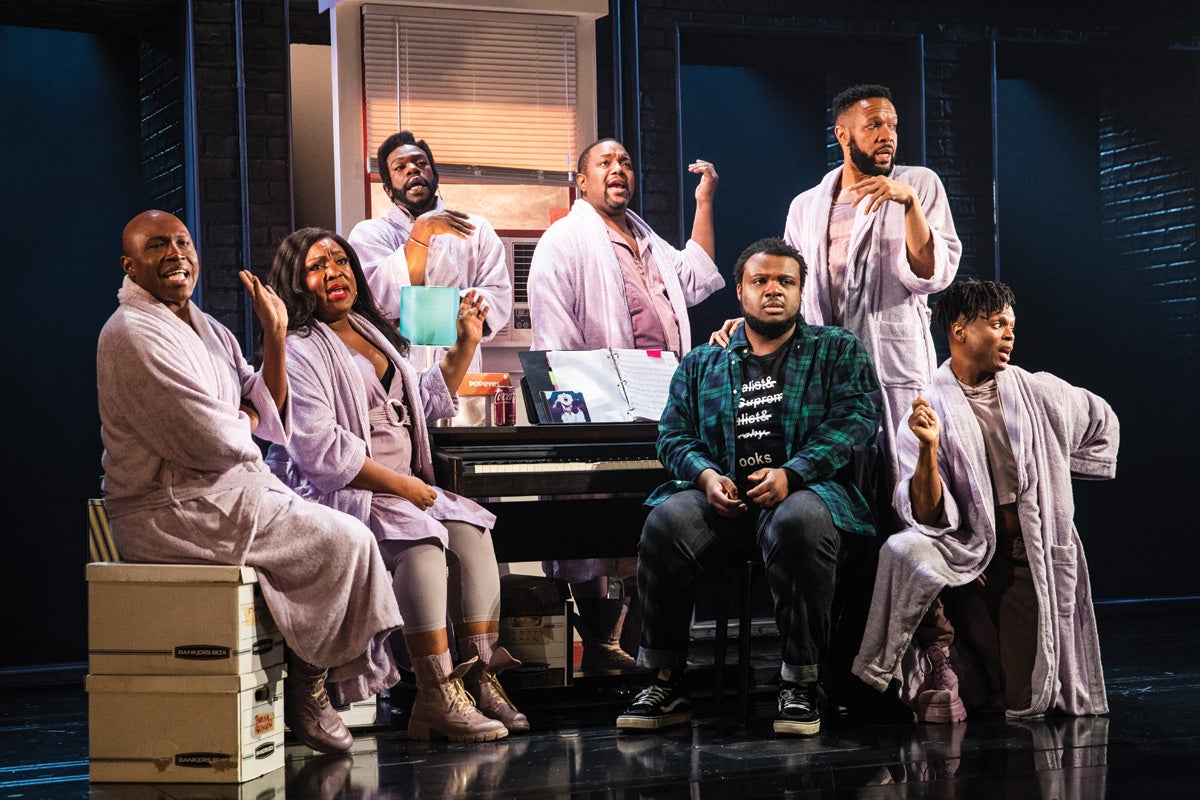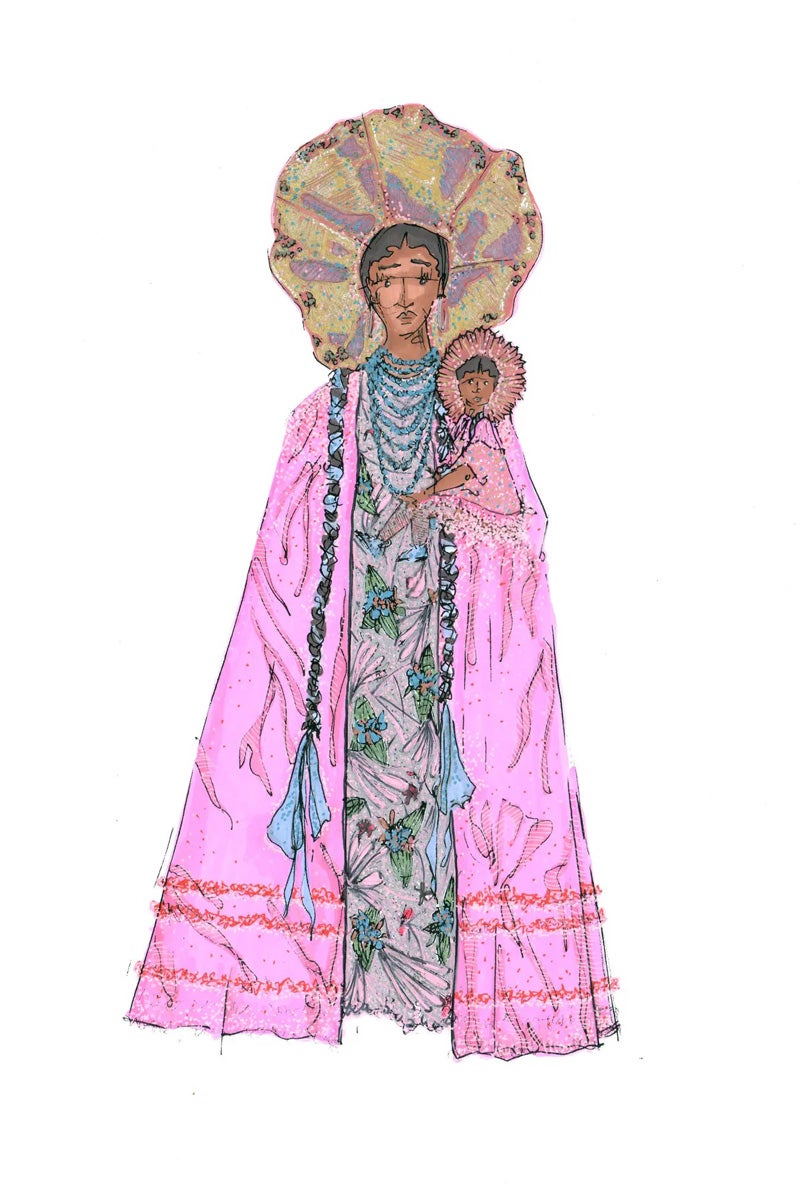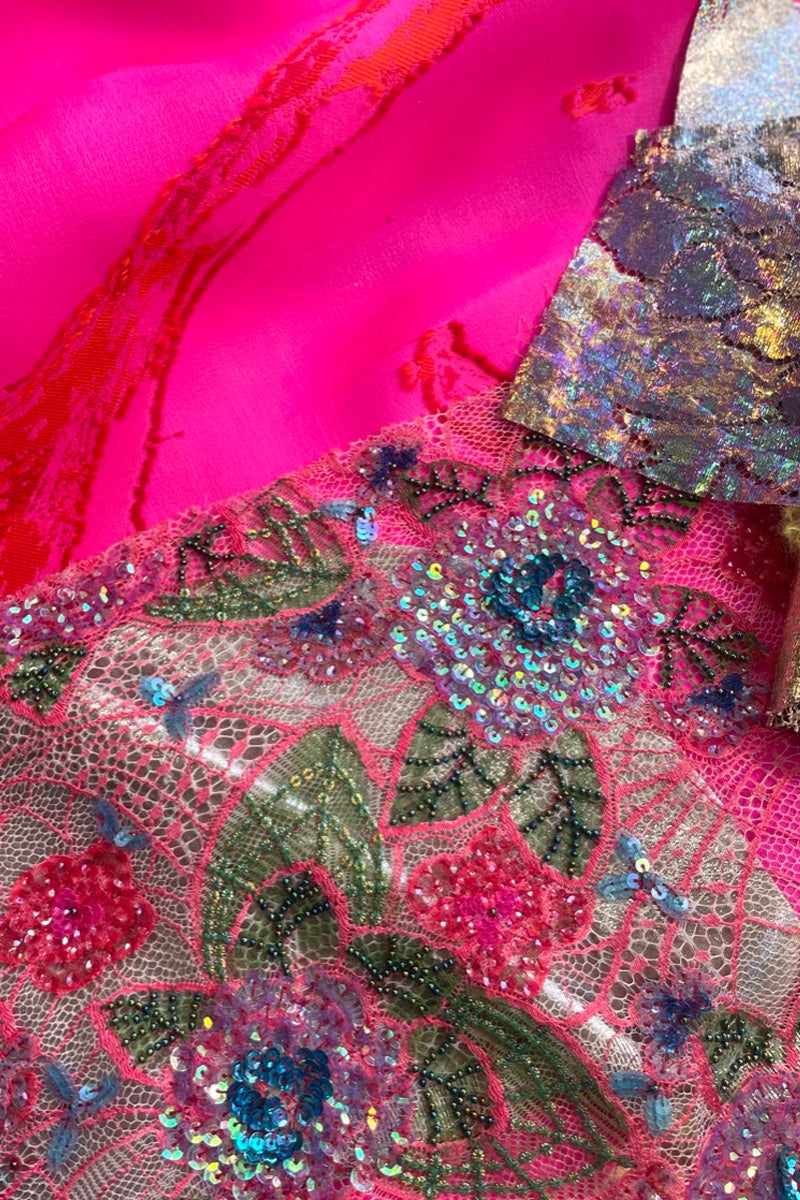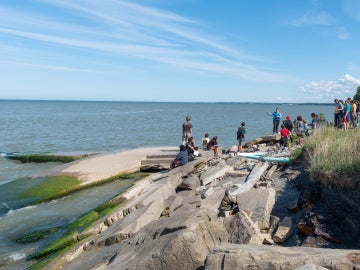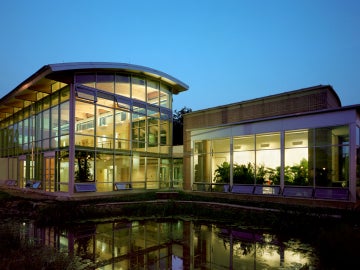Oberlin Alumni Magazine
Treasure Hunting
A peek into the expansive world of Tony-winning costume designer Montana Levi Blanco '07
June 4, 2025
Serena Zets '22

Montana Levi Blanco '07 uses his research skills and love of history to create beautiful costumes that actors love to wear.
Photo credit: Samantha Jane
Montana Levi Blanco '07 has been on a treasure hunt his whole life. Growing up in Albuquerque, New Mexico, Blanco spent his childhood playing in the studio of his grandmother, a lampshade artisan. Some of his earliest memories involve toying with beads and cutting electrical wire to create makeshift arts and crafts projects. Just like his grandmother, he developed a knack for turning simple materials into intricate creations—and crafting a new world with his own hands.
Decades later, as a costume designer living and working in New York City, Blanco designs worlds so vivid and textured that they transform sold-out theaters into other places. “When I started to train and learn about materials—how they’re made, how they’re woven—I realized that I had this subconscious knowledge and memory of what types of materials might be more appropriate for certain garments or what’s not good for movement,” he says. “And I think that comes from being around it so much so young. Everything I work with now are things I've been touching and engaging with since my earliest memories.”
Since committing his professional life to costume design in 2011 while on a fellowship at the McNay Art Museum, Blanco has worked on some of the most exciting productions in New York, including costuming two Metropolitan Opera productions (Champion and El Niño) and Michael R. Jackson’s acclaimed Broadway musical A Strange Loop. But his Broadway debut, for the 2022 revival of Thornton Wilder’s The Skin of Our Teeth, was even more impressive: Blanco won a Tony for Best Costume Design in a Play.
Incredibly enough, A Strange Loop won Best Musical and Best Book of a Musical that same night, meaning Blanco was suddenly the costume designer for two Tony-winning shows. But he was even more thankful that his most important inspiration—his grandmother—witnessed this win. “I dedicate this to my mother and grandmother,
two Mexican American single mothers,” Blanco said in his acceptance speech. "They are the reason I am here."
Several years later, his gratitude for his grandmother is still evident. “She could see that all the love and work that still evident. “She could see that all the love and work that she put into me and my mom meant something,” Blanco says. “Something came from it. Yes, there’s professional validation, but there are moments that come along that matter to your family. My grandma could go to church, and people knew about the Tony.”
Blanco’s Tony win closed the loop on the familial legacy of creation introduced to him by his grandmother; it also propelled him into a future of professional opportunity. Through the end of 2026, Blanco has multiple projects opening across the country, including This House performed by Opera Theatre of St. Louis and the highly anticipated Purple Rain world premiere at the State Theatre in Minneapolis. “What a blessing to be in a profession where you can engage in this full kaleidoscope and the full depth of the human experience in a really deep way,” he says.
Montana is the costumer designer for A Strange Loop (left), which won Tony Awards for Best Musical and Best Book of a Musical. He also won his own Tony for Best Costume Design in a Play for the 2022 revival of Thornton Wilder's The Skin of Our Teeth (right).
Another one of Blanco's early memories is “treasure hunting” at estate sales and yard sales with his family. “It’s fully incorporated into every thread of what I do, a little bit of treasure hunting,” he says. “You’re sifting, sifting, sifting—and then there’s this emotional connection to an object. I really do feel like there is a creative art to
to an object. sifting through the overlooked to find the gem.”
Blanco still spends his free time sifting through estate sales, thrift stores, and costume shops hoping to find the right gem for the next of his many projects. A large part of being a costume designer is weaving together these tiny treasures into a cohesive visual landscape. Designers must remain attentive to how the drape of a dress moves when an actor is dancing, how the lead’s jewelry looks under stage lights during their final monologue, whether a mask will work with a mic, and so much more.
“What I’ve realized about doing costume is that the aesthetic final product part of it is really 30 to 40 percent of what I do,” Blanco explains. “A lot of what I do is looking at the world, observing the world, observing how people dress in a way that tells some kind of story about who they are.”
Designing The Skin of Our Teeth required Blanco to create over 100 costumes covering three distinct American time periods: the Civil War, the 1920s, and the mid-20th century. All of the costumes are brightly colored, structured, and layered. For example, his favorite costume from The Skin of Our Teeth is worn by the Fortune Teller, who is introduced in Act 2 as a fixture of the 1922 Atlantic City boardwalk. While researching materials, Blanco found a “gorgeous piano shawl from the 1920s” that became the skirt and “aesthetic centerpiece” of the outfit.
“It was also a relic from the historical period we were depicting onstage, giving the clothing a subtle aura of depth and honesty,” he adds. “For me, it was important to imbue this costume with a sense of antiquity and age. My design research led me to period photography of mystics, soothsayers, and Romani peoples. One thing I found quite beautiful in this imagery was the collaging of numerous fabrics into a single garment. It is as if each textile was collected over time, each textile a singular story to tell.”
Perfecting these details requires a close eye and a deep care for the work, which is why Blanco’s approach is rooted in a compassionate witnessing of the actor in front of him. The emotional integrity of a costume—and an actor’s comfort in wearing it—matters as much as historical accuracy.
Now, Blanco spends the first rehearsal taking note of what each actor is wearing to gauge what types of clothing makes them feel most comfortable and confident. During subsequent fittings with actors leading up to opening night, he asks them questions about what clothing feels most affirming for them to ensure that they’re best equipped to do their job.
“My most fulfilling moments in the theater have been moments of deep vulnerability with performers,” Blanco says. “Some of that includes working with actors with disabilities and learning how to support them, clothe them, and make them feel strong—[or] working with actors with different gender expressions, some fully formed and some in different moments of development.
“I didn’t realize I had all these human skill sets that would be valuable as a costume designer,” he continues. “There’s a deep responsibility we have as costume designers that goes far beyond the clothes and the character. It’s really about two humans learning about
each other and supporting each other.”
The marriage of emotion and precision reflects the tactile knowledge Blanco developed as a child, paired with the research methodologies he honed at Oberlin, having graduated with a double degree in history and oboe performance. Although Blanco didn’t participate in any theater productions or operas—in fact, he never even played in an orchestra pit or for an opera—Oberlin nevertheless prepared him for a career in the theater.
Blanco would visit the bookstore during add-drop at the start of every semester to survey the required books for each class and choose his electives based on what readings drew him in. Over time, he realized that history classes called to him; in fact, he viewed Emerita
Professor of History Carol Lasser as a mentor. “By the end of my time at Oberlin, Carol helped me realize that I was interested in disparate histories and how these histories were in conversation with each other,” Blanco says. “These comparative histories are very applicable to what I do now.”
The late oboe professor James Caldwell also played a foundational role in Blanco’s creative practice and approach to leadership. (Caldwell’s love for bonsai trees—
and how he viewed tending to his trees as similar to caring for his students—stuck with Blanco; in fact, Blanco credits his love of plants to the professor.) Studying music in a
conservatory environment also “teaches you discipline, failure, practicing, and competition,” Blanco says. “And you are one part of of this greater whole. It’s very similar to the theater.”
Looking back, Blanco says his time at Oberlin cultivated what he describes as an “intimate
expansiveness” that demanded he learn widely about new things—and learn more deeply about the things he thought he already knew. “Every project I do requires a new set of books and movies and exhibitions you can go to and conversations you can have. ... It combines all of these things that Oberlin taught me: a love of reading, learning, and conversation.”
After Oberlin, he earned a master’s degree in public humanities at Brown University and an MFA in design at the Yale School of Drama. While in these programs, Blanco thought about the experience of the broader public engaging with his curatorial work, which led
him to costume design. “The fact that I discovered the theater at 27 shows you can do two professional trainings and think that’s what your life’s purpose is, and you can still find later on what your life’s next purpose is,” Blanco says. “I’m only 40; I may have a moment where I find another life’s purpose.”
Every project I do requires a new set of books and movies and exhibitions you can go to and conversations you can have.
Montana Levi Blanco '07
Blanco and his Yale classmate Lileana Blain-Cruz, the director of both The Skin of Our Teeth and El Niño, also cultivated a collaborative working relationship that helped shape their respective careers. “When I moved to New York, Lileana went to these
institutions and producers and advocated for me and got me my first jobs off-Broadway,” Blanco says. “That’s how I also started. I owe her a lot. A lot of my trajectory is tied to
the directors and crews I work with.”
As it happens, Blain-Cruz is directing Purple Rain, while another one of the pair’s longtime friends and collaborators, the Pulitzer Prize finalist Branden Jacobs-
Jenkins, wrote the play adaptation. For Blanco, the first step in preparing for a project as massive as Purple Rain is to do his usual archival research and extensive reading so he can “pull any images that are evocative or inspirational,” he says. “You have to prepare your eye and your mind. In many ways, the theater is the study of humanity and relationships.”
Since graduating, Blanco has accumulated an extensive library of books; among his greatest textual influences are Isabel Wilkerson’s nonfiction masterpiece about the Great
Migration, The Warmth of Other Suns, and Min Jin Lee’s fictional epic Pachinko. “As a designer, it’s our tools,” he says of this library. “We have this resource of the internet
and Googling things, but it’s important to reference physical books that you’re not going to encounter on the internet.” Ever the historian and storyteller, Blanco is particularly inspired by generational family epics, both fiction and nonfiction. “The specificity of character and nuance of familial dynamics over a period time is a gift for any storyteller—and most certainly for a costume designer,” he says. “These books have a profound way of
telling the story of a people—or a nation—by chronicling the minutiae of everyday existence.”
The Minneapolis premiere of Purple Rain is billed as “pre-Broadway,” meaning that Blanco’s return to Broadway is likely imminent. In 2026, Blanco will also return to the Metropolitan Opera for Lincoln in the Bardo, an opera once again directed by Blain-Cruz.
It’s an ambitious time that Blanco is well prepared for with his scavenged treasures, beloved books, curious friends, and supportive family by his side. After all, the productions he works on are richer, more vibrant, more colorful, and more emotionally compelling because of the love and attention he gives to not just the costumes, but his team, the actors, and the original works.
“I think that love is really threaded through every element of costume,” Blanco says. “We are dealing so intimately with the performers, the actors. Love is threaded into the joy and the safe space my team creates. Love is threaded into the creative team we’ve been working with for over a decade. ... Being a costume designer involves so much emotional and human connection that is very private and very intimate. That’s where this thread of love comes through.”
Serena Zets ’22 is a Washington, D.C.-based freelance journalist and essayist and a regular contributor to Washington City Paper. This story originally appeared in the Spring 2025 issue of the Oberlin Alumni Magazine.
On the cover:
Montana Levi Blanco '07 is photographed in front of his wall of research materials in his New York City apartment, spring 2025. Photo by Samantha Jane.
You may also like…
Research Roundup
Every day, Oberlin’s faculty and students produce scholarly work that uncovers new insights into how we understand the world, particularly in the areas of sustainability and the environment.
Building a Legacy
As the Adam Joseph Lewis Center for Environmental Studies turns 25, Oberlin's world-changing alums carry its impact forward.
Food for Thought
Oberlin’s academic offerings and Northeast Ohio’s unique agriculture scene are havens for students passionate about food studies.
